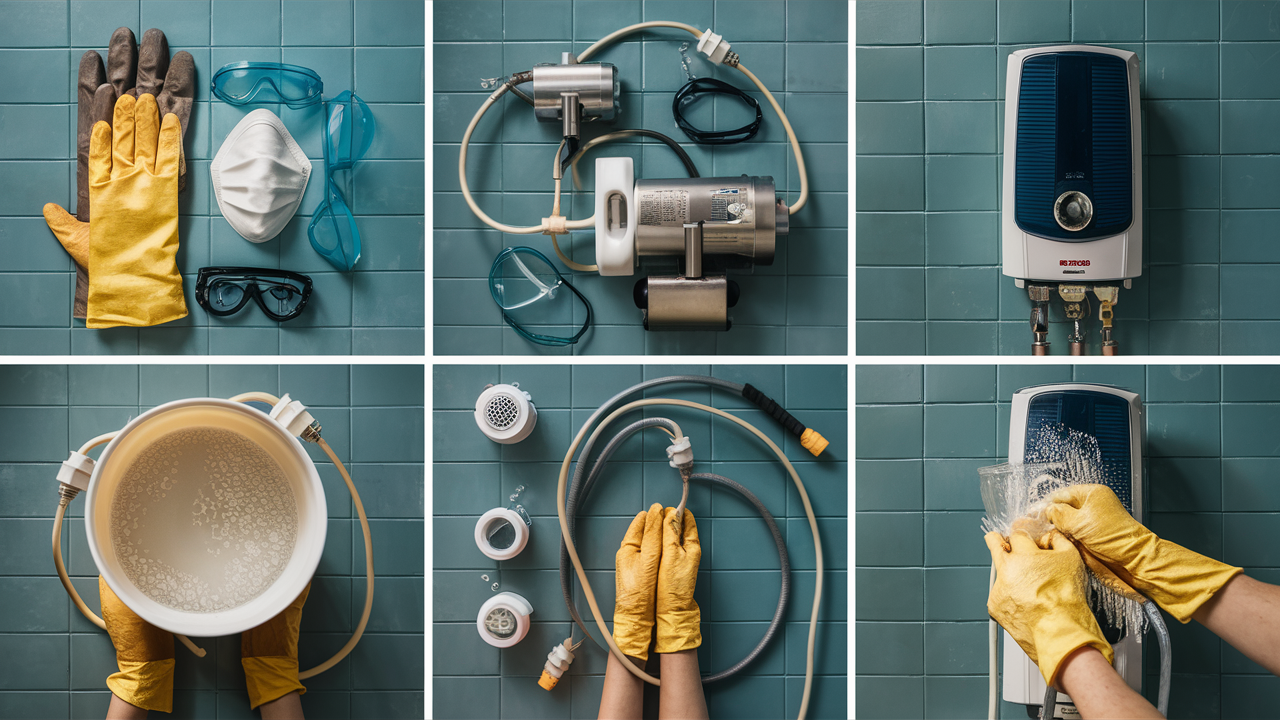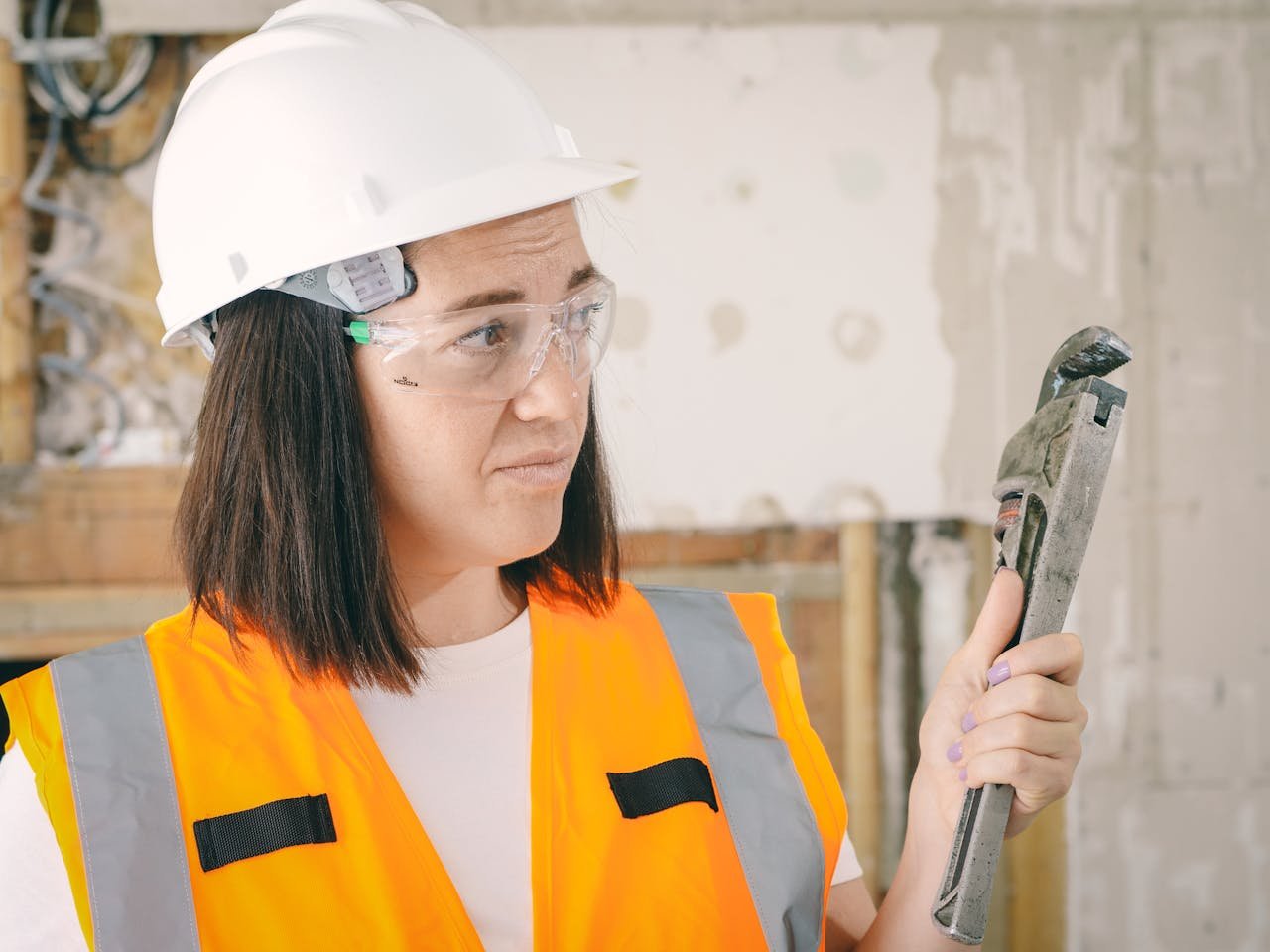DIY Tankless Water Heater Cleaning
Keeping your tankless water heater clean is crucial for its efficiency, lifespan, and hot water output. While professional cleaning is an option, many homeowners are interested in tackling this task using DIY cleaning methods. This detailed tutorial will explore the benefits and potential risks of cleaning your tankless water heater. I’ll provide a clear picture of the signs that indicate your unit needs cleaning and, most importantly, a detailed step-by-step process for DIY cleaning your tankless water heater with safety precautions in mind. Finally, I’ll help you decide if DIY cleaning is the right approach and explore the advantages of professional cleaning services. Let’s learn how to clean tankless water heaters using DIY Methods at home.
Regular cleaning of a tankless water heater offers several key benefits.
Firstly, it improves efficiency by eliminating mineral deposits and buildup that can impede the heating process. The water heater operates more effectively with a clean system, heating water quickly and efficiently. Additionally, cleaning contributes to an extended lifespan of the tankless water heater. Regular maintenance helps preserve the integrity of the heater’s components by preventing scale buildup and corrosion, reducing the likelihood of premature wear and tear.
Moreover, maintaining a clean tankless water heater ensures water pressure throughout your home’s plumbing system. Clean components allow for proper water flow and pressure, preventing issues such as reduced flow rates or fluctuations in water pressure. Furthermore, cleaning provides an opportunity to troubleshoot potential problems with the water heater. Regular inspection during the cleaning process allows homeowners to identify and address any signs of wear, damage, or malfunction, thereby avoiding more significant issues.
Finally, one of the most significant advantages of DIY cleaning is the cost savings it offers over time. By performing routine maintenance, homeowners can eliminate the need for professional cleaning services, saving money on maintenance expenses in the long run. This approach ensures the continued optimal performance of the tankless water heater and provides peace of mind, knowing that the system is being adequately maintained without breaking the bank.

When considering DIY tankless water heater cleaning, it’s essential to know the potential risks involved.
One significant risk is the dangers of improper cleaning methods. Without proper knowledge and guidance, homeowners may inadvertently use harsh chemicals or abrasive tools that can damage the water heater’s internal components. Improper cleaning techniques can lead to corrosion, leaks, or even electrical hazards, posing safety risks to the homeowner and the property.
Another risk associated with DIY cleaning is the possibility of voiding the warranty by attempting DIY cleaning. Many manufacturers specify in their warranties that any unauthorized repairs or maintenance performed by the homeowner may void the warranty. Suppose the water heater sustains damage during a DIY cleaning attempt. In that case, the manufacturer may refuse to cover the cost of repairs or replacement under warranty, leaving the homeowner responsible for the expenses.
Furthermore, there is a risk of damaging the tankless water heater during DIY cleaning. Without proper training or experience, homeowners may inadvertently cause damage to the delicate components of the water heater, such as the heating elements, sensors, or valves. Even a small mistake during the cleaning process can lead to significant damage that requires costly repairs or replacement of the entire unit. Therefore, homeowners should carefully weigh the risks and benefits before attempting DIY cleaning of their tankless water heater and consider seeking professional assistance if unsure of the proper procedures.
Knowing the signs that your tankless water heater needs cleaning is crucial for maintaining its optimal performance.
One of the most common signs is reduced hot water output from the tankless water heater. If you notice that your water heater is no longer producing as much hot water as it used to, it could be a sign of mineral buildup or other obstructions that impede water flow.
Another indication that your tankless water heater may need cleaning is increased energy consumption. A buildup of mineral deposits or sediment within the heater can cause it to work harder to heat the water, resulting in higher energy usage and potentially higher utility bills. Monitoring and comparing your energy consumption to previous usage patterns can help identify if your water heater is operating less efficiently.
Additionally, unusual noises from the tankless water heater can signal the need for cleaning. Strange sounds such as popping, banging, or gurgling noises may indicate that mineral deposits have accumulated within the heater, causing disruptions in the heating process. These noises can also signal air bubbles trapped in the system, which can be resolved through proper cleaning and maintenance.
Fluctuations in water temperature from the tankless water heater are another telltale sign that cleaning may be necessary. If you experience sudden changes in water temperature, such as hot water turning cold or vice versa, it could indicate that mineral buildup or other obstructions are affecting the heater’s ability to maintain a consistent temperature.
Finally, visible mineral buildup on tankless water heater components clearly indicates that cleaning is needed. Check the heating elements, sensors, and other internal components for signs of scale or sediment accumulation. If you notice a white or yellowish residue on these parts, the mineral buildup is likely affecting the heater’s performance and efficiency, necessitating cleaning to restore optimal operation.

DIY Tankless Water Heater Cleaning Tools & Supplies
First and foremost, prioritize your safety by ensuring you have the appropriate safety gear. This may include gloves, goggles, and even a face mask to protect against any splashes or fumes from cleaning solutions.
- White vinegar is one of the most effective cleaning agents for tankless water heaters. Its acidic properties help dissolve mineral deposits and scale buildup inside the heater, restoring its efficiency and performance.
- You’ll also need a submersible pump to facilitate the cleaning process. This pump will circulate the vinegar solution through the water heater, thoroughly cleaning its internal components.
- You’ll need hoses to connect the submersible pump to the tankless water heater. These hoses transport the vinegar solution from the pump to the heater and back again, allowing for continuous circulation and cleaning.
- Finally, you’ll need a bucket to mix and contain the vinegar solution. This bucket will hold the diluted vinegar solution before it’s pumped into the water heater, making it easier to manage and control the cleaning process.
Step-by-Step Guide: How to Clean Tankless Water Heater Using DIY Cleaning Methods
Step 1: Disabling Power and Water Supply to Tankless Water Heater
Before starting any maintenance or cleaning, turn off the power supply to the tankless water heater. Locate the circuit breaker or power switch dedicated to the heater and switch it off. Additionally, shut off the water supply to the heater to prevent any water flow during the cleaning process.
Step 2: Attaching Hoses and Submersible Pump for Vinegar Circulation
Attach one hose to the hot water outlet and another to the cold water inlet of the tankless water heater. Connect these hoses to a submersible pump. Place the pump in a bucket filled with vinegar solution. Ensure the hoses are securely attached to prevent leaks.
Step 3: Running Vinegar Solution Through Tankless Water Heater
Turn on the submersible pump to circulate the vinegar solution through the tankless water heater. Let the solution run through the heater for at least 60 minutes to dissolve mineral deposits and scale buildup inside the unit. Check periodically to ensure the solution continues to flow smoothly.
Step 4: Flushing the System with Clean Water
After the vinegar solution has circulated for the required time, disconnect the hoses from the submersible pump. Flush the system thoroughly by running clean water through the heater. This helps remove any remaining vinegar and loosened debris from the unit.
Step 5: Reassembly and Restarting the Tankless Water Heater
Once the system has been thoroughly flushed, reattach the hoses to their original positions on the tankless water heater. Turn on the water supply and ensure all connections are tight and secure. Finally, restore power to the heater by turning on the circuit breaker or power switch.
Safety Precautions While Cleaning the Tankless Water Heater
- Always wear protective gloves and eye gear to prevent contact with cleaning solutions and hot water.
- Make sure the tankless water heater is completely cooled down before starting the cleaning process to avoid burns.
- Use caution when working with electrical components and water to prevent the risk of electric shock.
- Work in a well-ventilated area to avoid inhaling any fumes from cleaning solutions.
Troubleshooting Common Issues During DIY Cleaning
- Low water flow: Check for obstructions in the water inlet or outlet pipes and clean or remove any debris blocking the flow.
- Strange noises: If you hear unusual sounds during cleaning, it could indicate air pockets or mineral buildup. Flush the system again to remove any trapped air or debris.
- Leaks: Inspect all connections and hoses for leaks. Tighten any loose fittings or replace damaged hoses to prevent leaks during operation.
- Error codes: If your tankless water heater displays errors after cleaning, consult the user manual to identify the issue. It could indicate a problem with the heating element, sensors, or other components. If unsure, contact a professional for assistance.

Professional Tankless Water Heater Cleaning Services
Advantages of Professional Cleaning for Tankless Water Heater
Professional cleaning ensures thorough maintenance by experienced technicians equipped with specialized tools, reducing the risk of overlooked issues. Safety protocols and expertise prevent accidents, and compliance with warranty requirements is guaranteed.
Comparison of DIY vs Professional Cleaning for Tankless Water Heater
DIY cleaning may save costs but requires time and effort. Moreover, it poses risks of incomplete cleaning or damage. Professional services offer convenience, thoroughness, and peace of mind, ideal for homeowners prioritizing efficiency and warranty compliance.
Costs Associated with Professional Cleaning of Tankless Water Heater
Professional cleaning costs vary based on factors like heater size and cleaning extent. Average costs range from $100 to $300 or more, with additional fees possible for repairs. Despite higher initial costs, professional cleaning offers long-term savings through extended heater lifespan and reduced repair risks.
FAQs: Cleaning Tankless Water Heaters
How often to clean a tankless water heater?
The frequency of cleaning a tankless water heater depends on factors such as water hardness and usage. Generally, maintenance is recommended annually to prevent mineral buildup and ensure optimal performance.
Does warranty coverage work for DIY cleaning of a tankless water heater?
Most warranties require professional maintenance to remain valid. If not done according to manufacturer guidelines, DIY cleaning might void warranties. It’s crucial to check warranty terms before attempting DIY maintenance.
Is DIY cleaning suitable for all tankless water heater models?
DIY cleaning may be feasible for some models, but not all. Complex systems or specific issues might require professional expertise. Homeowners should consult the heater manual or manufacturer for guidance.
What are the Alternative cleaning solutions for tankless water heaters?
Other solutions, like citric acid or specialized descaling products, are effective besides vinegar. However, ensuring compatibility with the heater and following manufacturer recommendations is essential. Professional cleaners may also offer alternative solutions tailored to specific needs.
I hope you enjoy reading this article on cleaning a Tankless Water heater using DIY Methods. For more cleaning hacks and tips, please click the link below.
